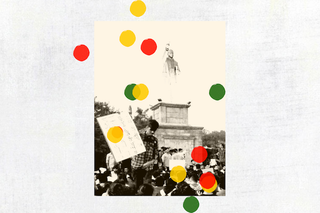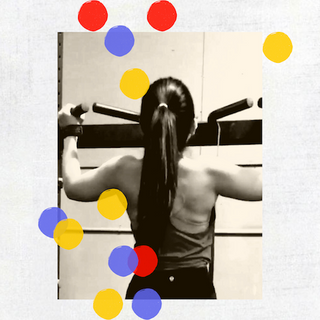
India Dissents: How People Rallied for Causes on the Ground in 2020
“If I didn’t go and raise my voice for things I saw were wrong, what was the point of my education?”

The Swaddle asked people across India how they spoke truth to power, found their voices, and stood up for themselves in 2020. In this installment, how four people exercised their right to protest in public.
Bhagwan Mahaveer Wildlife Sanctuary and Mollem National Park are treasures that Goans take pride in and the largest protected forests of the state. These beautiful forests protect not only several rare and endangered flora and fauna but also are home to tribal communities and responsible for the rainfall over north Goa. There are three projects proposed in these forests. … An “estimate” of 59,000 trees are to be felled. The projects have been approved for easy and increased transportation of coal.
I came to know about the projects back when the lockdown had just started. It nearly reduced me to tears to know that amidst the climate crisis and a dangerous pandemic, our forests had planned to be felled for projects that did not even benefit the citizens of the state. A couple of my friends and I drafted two letters that were directed to the State and Center as well as the Supreme Court. We got more than 400 students to be signatories. This is when the idea of having an independent page focusing on student dissent was born.
Alas, the state feigned ignorance and still continues to do so. Things got so bad that in the first week of November, risking our lives and sacrificing our sleep, more than 5000 Goans gathered on the railway track at Chandor, at midnight, to stop the double-tracking work that had commenced. This was my first on-ground protest; it was an amazing experience. After that protest, this issue gained national attention with some actors and journalists actively talking about this issue. Faye D’souza and The Quint are a few examples of the same. Personally, this campaign has been a wholesome journey so far and I realize it’s going to be a long fight. I know that I will not back out — no matter how tired I am. I will keep fighting.
— Mithila Prabhudesai, 21
*
Fridays For Future Shillong, which is part of the global youth movement advocating for intersectional environmental justice, organized a protest against the construction of a shopping mall in Shillong. We organized a social media campaign, wherein participants could take a picture of themselves at the Public Works Department (PWD) Office premises and upload it on social media by tagging the Chief Minister’s Office and with the hashtag #NoToBarikMall. Concomitantly, we organized the physical protest by forming a human chain around the three-acre premises.
Our concern against the construction of a mall stems from the fact that there is a lack of transparency over how the issue of urban planning is undertaken in our city and a wastage of funds from the public coffer. However, beyond the obvious is the fact that there is an underlying problem — the issue of gentrification in Shillong. The construction of the planned city has been fraught in controversy. Most of the land acquired [for construction] has been by non-indigenous entities, which is in violation of the Meghalaya Land Transfer (Regulation) Act as well as provisions of the Sixth Schedule of the Indian Constitution.
Our city cannot proceed into the threshold of ‘modernity’ and ‘development,’ if it chooses to do it selectively, for only the few and the privileged.
— Joel Kyndiah, 18
*
When CAB was passed, I felt as if someone would come and throw us out or kill us. Being a child of an interfaith couple, my panic was on another level. There was always this looming fear of attacks in my own house or whenever I went to college. I was afraid somebody would lynch me after learning my name. I started driving very carefully, afraid that if I were to be stopped for something, they would find out my name.
After I started attending protests, my attitude towards CAA-NRC — the sudden realization of the threat of a fascist government — went from cynical to hopeful and confident. Online, it was exhilarating how so many people came together in different cities, which really made me understand that there is still a lot of hope. Offline, when I attended the protests, I would feel a rush of adrenaline, a new type of confidence and positivity. It was amazing how so many people came and even on days where the number of protesters would not cross 30, it was still a great atmosphere because of the discussions we had. There was a small library setup ( the organizers arranged some books and some were given by volunteers ) of books regarding related issues. Songs were sung and speeches were made.
The only time during the protests I would feel uncomfortable was when I would see the police. All those videos from Delhi would come to mind and I would keep staring at the lathis. There were moments while protesting where I would plan what to do just in case violence erupts. I think, despite all the positive encouragement you get on social media, one can only understand it all when you physically protest with people and discuss with them.
— S., 20
*
2020 has without a doubt been a difficult year. There is so much that has happened globally and so much resistance that has been shown. One of the ways in which I showed dissent this year was by going to the anti-CAA and anti-NRC protests. When the protests first started towards the end of November of 2019, I have to admit I was too scared to go. So initially I spent time just reading up and educating myself as much as I could about the act, the problems with it, and what it was doing. Then I started talking to my parents, but they didn’t seem to be on the same page as me. Whenever I tried to talk to my parents, especially my father, I got told I didn’t understand the ways of the world, I didn’t understand how difficult it was to run a government, and I was naïve and young. It was extremely frustrating to have the conversation over and over, but I kept trying.
Then when the attack on Jamia Millia Islamia took place on 15th December, I knew I couldn’t hold back anymore. I knew it was necessary to go and raise our voices, so I went for a protest with my college friends, without telling my parents. I wouldn’t pick their call when I was out and I kept making excuses.
In January of 2020, I got tired of being condescended to by my father. I knew that I was trying my best to keep myself educated and aware about what was happening and joining in a fight I genuinely believed in. It felt like everything around us was on fire, and I didn’t find the need to lie to my father anymore, even if he disagreed. I started informing them on the family group chat. After I reached protests sites, I started sending videos and pictures of the protests. No one responded much, but I still kept doing it. My father started telling my mother how much I was not focusing on my academics. But I started to ignore the jibes. I balanced my academics with going to as many protests as I could attend. The most powerful ones were the women’s sit-in (I attended one in Pune). There was no place as buzzing with resistance and power as those. I told my father as much, even when he continued to give me the cold shoulder in such conversations.
I told my parents — if I didn’t go and raise my voice for things I saw were wrong, what was the point of my education? It is hard, and frustrating, and often lonely to fight at home. Especially when my arguments are treated with disrespect. But I have realized that love, empathy, and humanity are powerful tools of resistance and change and I have chalked a path to keep myself educated and aware; to grow and constantly strive to be better and do better while being constantly mindful of the kind of privileges I have.
— Abhramika Choudhuri, 20
Related


India Dissents: How People Challenged Restrictive Beauty Norms in 2020
